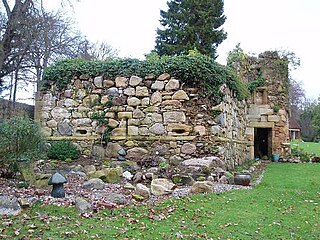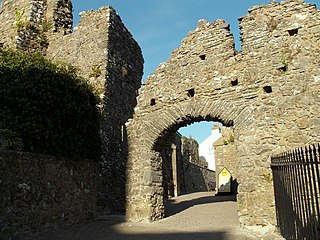
Pembroke Castle is a medieval castle in the town of Pembroke, Pembrokeshire in Wales. The castle was the original family seat of the Earldom of Pembroke. A Grade I listed building since 1951, it underwent major restoration during the early 20th century.

Tenby is both a walled, seaside town in Pembrokeshire, Wales, on the western side of Carmarthen Bay, and a local government community.

The Irish Confederate Wars, also called the Eleven Years' War, took place in Ireland between 1641 and 1653. It was the Irish theatre of the Wars of the Three Kingdoms – a series of civil wars in the kingdoms of Ireland, England and Scotland. The war in Ireland began with a rebellion in 1641 by Irish Catholics, who tried to seize control of the English administration in Ireland to force concessions for Catholics. This developed into an ethnic conflict between Gaelic Irish and old English Catholics on one side, and English and Scottish Protestant colonists on the other. Catholic leaders formed the Irish Catholic Confederation in 1642, which controlled most of Ireland and was loosely aligned with the Royalists. The Confederates and Royalists fought against the English Parliamentarians and Scottish Covenanters. In 1649, a Parliamentarian army led by Oliver Cromwell invaded Ireland and by 1653 had conquered the island.

The 1648 Second English Civil War is one in a series of connected conflicts in the kingdoms of England, incorporating Wales, Scotland, and Ireland. Known collectively as the 1638 to 1651 Wars of the Three Kingdoms, others include the Irish Confederate Wars, the 1638 to 1640 Bishops' Wars, and the Cromwellian conquest of Ireland.

Thomas Horton was an English soldier in the Parliamentarian army during the Wars of the Three Kingdoms, and Regicide.

The Battle of St Fagans was a pitched battle in the Second English Civil War in 1648. A detachment from the New Model Army defeated an army of former Parliamentarian soldiers who had rebelled and were now fighting against Parliament.

The Siege of Pembroke took place in 1648 during the Second English Civil War. In the engagement, Parliamentarian troops led by Oliver Cromwell sieged Pembroke Castle in Wales. The Castle had become a refuge for rebellious Parliamentarian soldiers after the end of the First English Civil War.

Major General Rowland Laugharne was a member of the Welsh gentry, and a prominent soldier during the Wars of the Three Kingdoms, in which he fought on both sides.

Richard Vaughan, 2nd Earl of Carbery KB, PC, styled The Honourable from 1621 until 1628 and then Lord Vaughan until 1634, was a Welsh soldier, peer and politician.

Sir George Munro, 1st of Newmore (1602–1693) was a 17th-century Scottish soldier and member of parliament from the Clan Munro, Ross-shire, Scotland. He was seated at Newmore Castle. Between 1629 and 1634 Munro held command in the Swedish army during the Thirty Years' War, and from 1642 in the Scottish Covenanter army during the Irish Confederate Wars before changing his allegiance to the Royalist cause of Charles I in 1648 during the Scottish Civil War and Irish Confederate Wars.
John Poyer was a Welsh soldier in the Parliamentary army during the English Civil War in South Wales. He later rebelled and was executed for treason.
Colonel Philip Jones was a Welsh military leader and politician who sat in the House of Commons between 1650 and 1656. He rose to the rank of Colonel in the service of the Parliamentary Army under Fairfax during the English Civil War. As Governor of Swansea he successfully held the town against the Royalist forces.
Early in the First English Civil War the Long Parliament threatened to retaliate in kind if the Royalists tried and executed John Lilburne and two other Parliamentary offices for treason. Lilburne later described this as the declaration of Lex Talionis, and it brought about a practical—rather than moral—mutual restraint by the parties to the war on how they treated prisoners of war.

Sir William Vaughan was a cavalry officer in the armies of Charles I of England. Initially serving in Ireland during the Confederate Wars, the outbreak of the First English Civil War led to him being sent to England in 1644, at the head of an Anglo-Irish cavalry regiment, to reinforce the Royalist army.

Tenby Castle was a fortification standing on a headland separated by an isthmus from the town of Tenby, Pembrokeshire, Wales. The remaining stone structure dates from the 13th century but there are mentions of the castle from as early as 1153. It is a Grade II* listed building.
Sir Hugh Owen, 1st Baronet was a Welsh politician who sat in the House of Commons variously between 1626 and 1660. He sided originally with the Parliamentarian side in the English Civil War, but the strength of his allegiance was in doubt.
Arthur Owen was a Welsh politician who sat in the House of Commons at various times between 1645 and 1678. He fought in the Parliamentary army in the English Civil War.
William Philipps was a Welsh politician who sat in the House of Commons in 1660.

Pill Fort was a sconce fort located on the northern shore of Milford Haven, Pembrokeshire. It was built by Royalist forces in order to prevent Parliamentarian forces landing at Pembroke Castle, and to protect Royalist forces landing from Ireland.

The Battle of Y Dalar Hir took place on 5 June 1648 in Caernarfonshire, North Wales, during the Second English Civil War. While little more than a skirmish, it had a significant effect on the local progress of the conflict.